Engineering Materials Practical 1: Tensile Properties Report
VerifiedAdded on 2023/01/10
|11
|1752
|69
Report
AI Summary
This report details the analysis of a practical experiment focused on the tensile properties of various materials, including copper, tin, brass, GPPS, and HIPS. The report is divided into two sections: a practical section where force vs. extension data was collected and stress vs. strain calculations were performed, and an analysis section where provided data was used to determine and compare mechanical properties. The report includes the analysis of stress-strain curves, calculations of yield stress, elastic modulus, tensile strength, and ductility, and a discussion of material behavior. The findings are presented in graphs and tables, comparing the stiffness, toughness, ductility, and resilience of the tested materials. The report also includes a comparison of the experimental results with published data and a discussion of factors that can influence the accuracy of tensile tests. Finally, it explores the properties and applications of brass in engineering contexts.
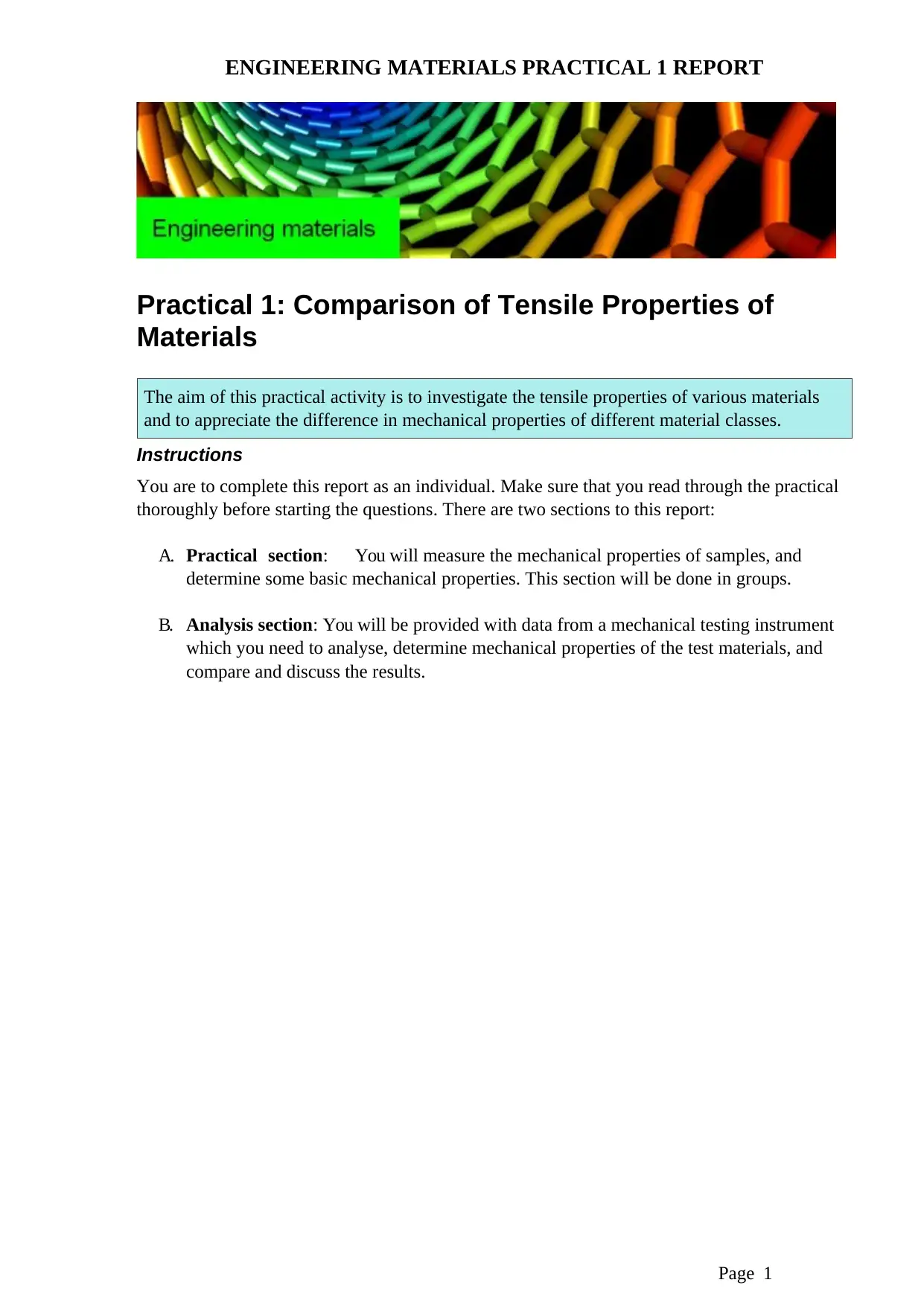
The aim of this practical activity is to investigate the tensile properties of various materials
and to appreciate the difference in mechanical properties of different material classes.
ENGINEERING MATERIALS PRACTICAL 1 REPORT
Page 1
Practical 1: Comparison of Tensile Properties of
Materials
Instructions
You are to complete this report as an individual. Make sure that you read through the practical
thoroughly before starting the questions. There are two sections to this report:
A. Practical section: You will measure the mechanical properties of samples, and
determine some basic mechanical properties. This section will be done in groups.
B. Analysis section: You will be provided with data from a mechanical testing instrument
which you need to analyse, determine mechanical properties of the test materials, and
compare and discuss the results.
and to appreciate the difference in mechanical properties of different material classes.
ENGINEERING MATERIALS PRACTICAL 1 REPORT
Page 1
Practical 1: Comparison of Tensile Properties of
Materials
Instructions
You are to complete this report as an individual. Make sure that you read through the practical
thoroughly before starting the questions. There are two sections to this report:
A. Practical section: You will measure the mechanical properties of samples, and
determine some basic mechanical properties. This section will be done in groups.
B. Analysis section: You will be provided with data from a mechanical testing instrument
which you need to analyse, determine mechanical properties of the test materials, and
compare and discuss the results.
Paraphrase This Document
Need a fresh take? Get an instant paraphrase of this document with our AI Paraphraser
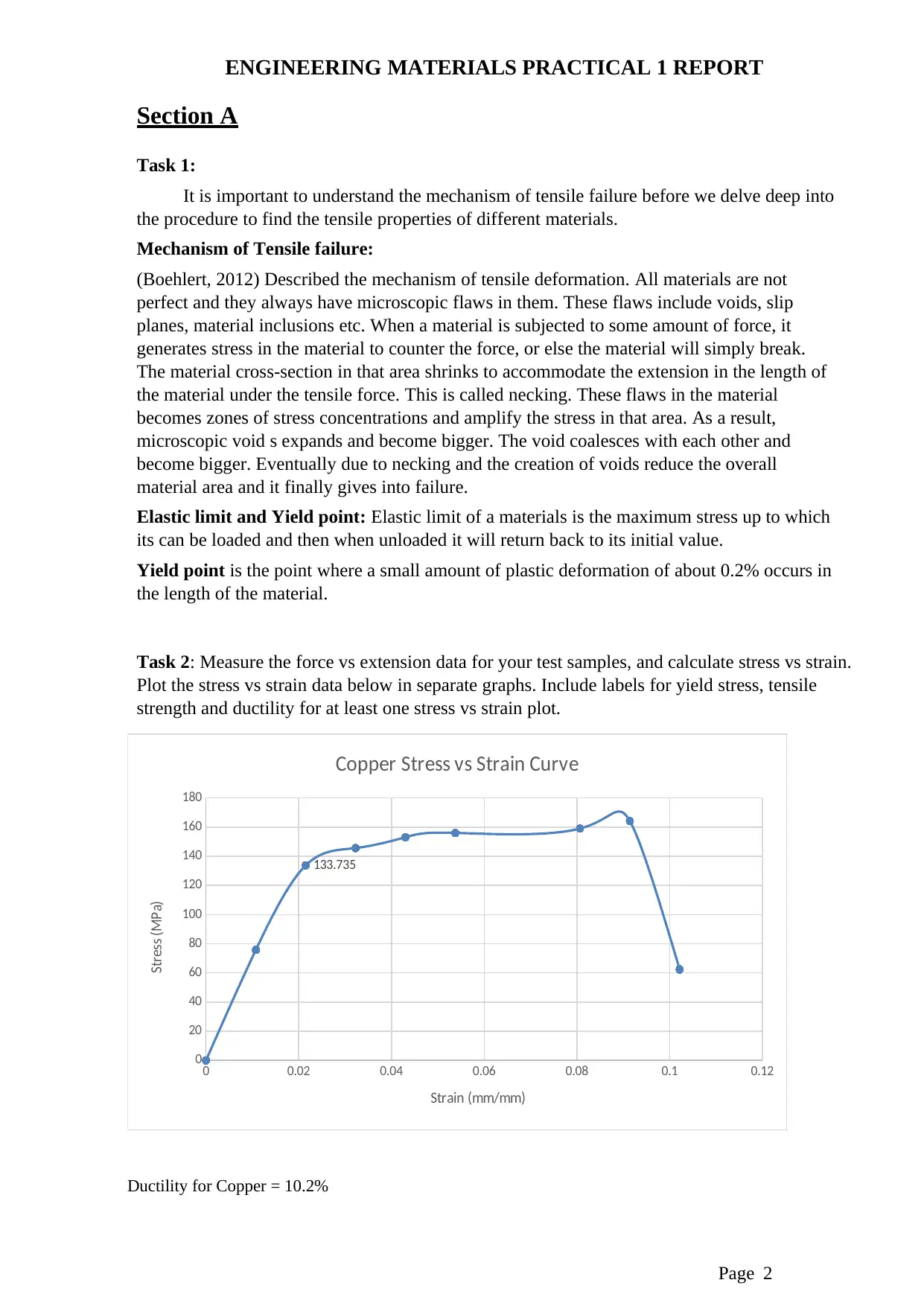
ENGINEERING MATERIALS PRACTICAL 1 REPORT
Page 2
Section A
Task 1:
It is important to understand the mechanism of tensile failure before we delve deep into
the procedure to find the tensile properties of different materials.
Mechanism of Tensile failure:
(Boehlert, 2012) Described the mechanism of tensile deformation. All materials are not
perfect and they always have microscopic flaws in them. These flaws include voids, slip
planes, material inclusions etc. When a material is subjected to some amount of force, it
generates stress in the material to counter the force, or else the material will simply break.
The material cross-section in that area shrinks to accommodate the extension in the length of
the material under the tensile force. This is called necking. These flaws in the material
becomes zones of stress concentrations and amplify the stress in that area. As a result,
microscopic void s expands and become bigger. The void coalesces with each other and
become bigger. Eventually due to necking and the creation of voids reduce the overall
material area and it finally gives into failure.
Elastic limit and Yield point: Elastic limit of a materials is the maximum stress up to which
its can be loaded and then when unloaded it will return back to its initial value.
Yield point is the point where a small amount of plastic deformation of about 0.2% occurs in
the length of the material.
Task 2: Measure the force vs extension data for your test samples, and calculate stress vs strain.
Plot the stress vs strain data below in separate graphs. Include labels for yield stress, tensile
strength and ductility for at least one stress vs strain plot.
Ductility for Copper = 10.2%
0 0.02 0.04 0.06 0.08 0.1 0.12
0
20
40
60
80
100
120
140
160
180
133.735
Copper Stress vs Strain Curve
Strain (mm/mm)
Stress (MPa)
Page 2
Section A
Task 1:
It is important to understand the mechanism of tensile failure before we delve deep into
the procedure to find the tensile properties of different materials.
Mechanism of Tensile failure:
(Boehlert, 2012) Described the mechanism of tensile deformation. All materials are not
perfect and they always have microscopic flaws in them. These flaws include voids, slip
planes, material inclusions etc. When a material is subjected to some amount of force, it
generates stress in the material to counter the force, or else the material will simply break.
The material cross-section in that area shrinks to accommodate the extension in the length of
the material under the tensile force. This is called necking. These flaws in the material
becomes zones of stress concentrations and amplify the stress in that area. As a result,
microscopic void s expands and become bigger. The void coalesces with each other and
become bigger. Eventually due to necking and the creation of voids reduce the overall
material area and it finally gives into failure.
Elastic limit and Yield point: Elastic limit of a materials is the maximum stress up to which
its can be loaded and then when unloaded it will return back to its initial value.
Yield point is the point where a small amount of plastic deformation of about 0.2% occurs in
the length of the material.
Task 2: Measure the force vs extension data for your test samples, and calculate stress vs strain.
Plot the stress vs strain data below in separate graphs. Include labels for yield stress, tensile
strength and ductility for at least one stress vs strain plot.
Ductility for Copper = 10.2%
0 0.02 0.04 0.06 0.08 0.1 0.12
0
20
40
60
80
100
120
140
160
180
133.735
Copper Stress vs Strain Curve
Strain (mm/mm)
Stress (MPa)
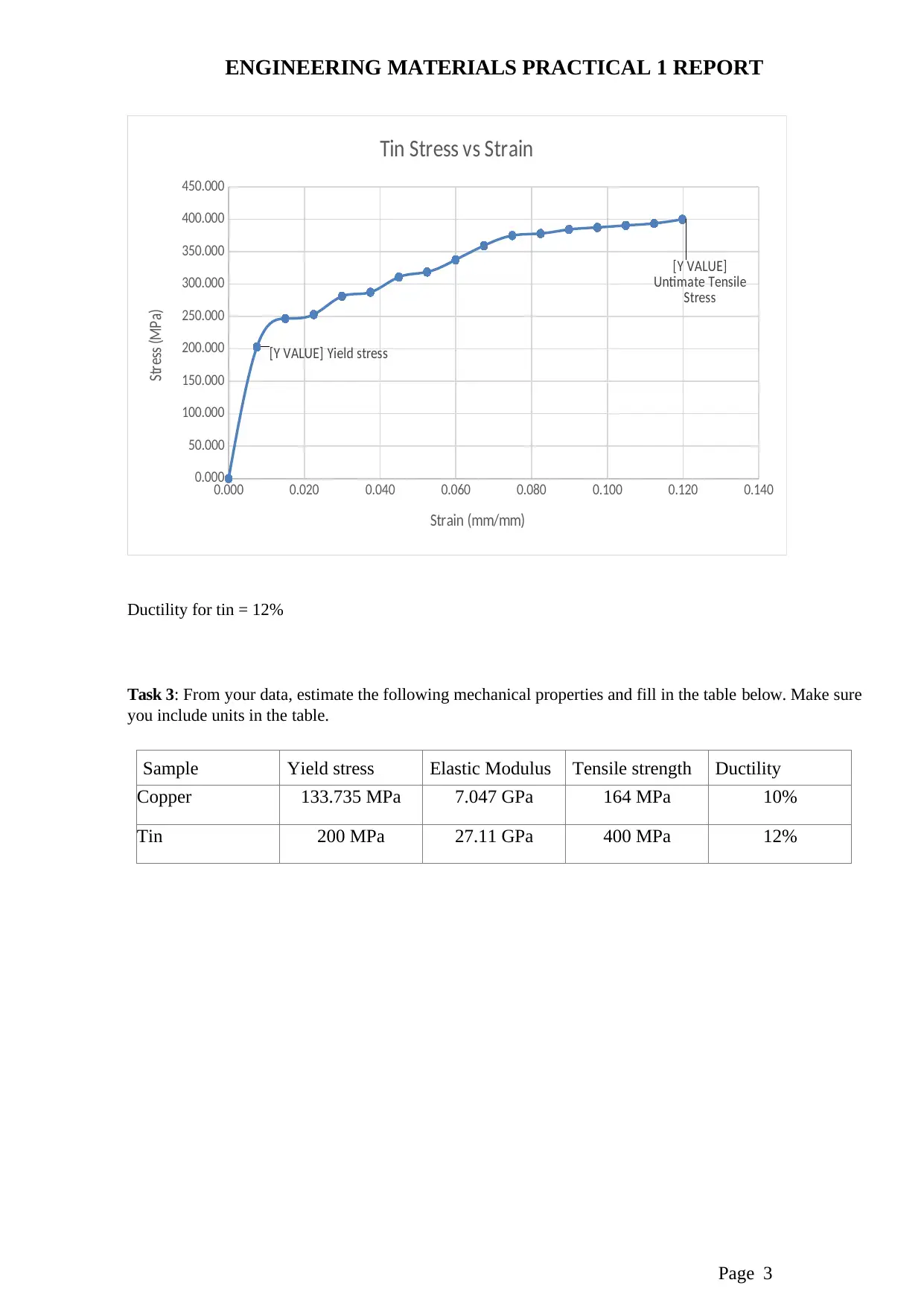
ENGINEERING MATERIALS PRACTICAL 1 REPORT
Page 3
0.000 0.020 0.040 0.060 0.080 0.100 0.120 0.140
0.000
50.000
100.000
150.000
200.000
250.000
300.000
350.000
400.000
450.000
[Y VALUE] Yield stress
[Y VALUE]
Untimate Tensile
Stress
Tin Stress vs Strain
Strain (mm/mm)
Stress (MPa)
Ductility for tin = 12%
Task 3: From your data, estimate the following mechanical properties and fill in the table below. Make sure
you include units in the table.
Sample Yield stress Elastic Modulus Tensile strength Ductility
Copper 133.735 MPa 7.047 GPa 164 MPa 10%
Tin 200 MPa 27.11 GPa 400 MPa 12%
Page 3
0.000 0.020 0.040 0.060 0.080 0.100 0.120 0.140
0.000
50.000
100.000
150.000
200.000
250.000
300.000
350.000
400.000
450.000
[Y VALUE] Yield stress
[Y VALUE]
Untimate Tensile
Stress
Tin Stress vs Strain
Strain (mm/mm)
Stress (MPa)
Ductility for tin = 12%
Task 3: From your data, estimate the following mechanical properties and fill in the table below. Make sure
you include units in the table.
Sample Yield stress Elastic Modulus Tensile strength Ductility
Copper 133.735 MPa 7.047 GPa 164 MPa 10%
Tin 200 MPa 27.11 GPa 400 MPa 12%
⊘ This is a preview!⊘
Do you want full access?
Subscribe today to unlock all pages.

Trusted by 1+ million students worldwide
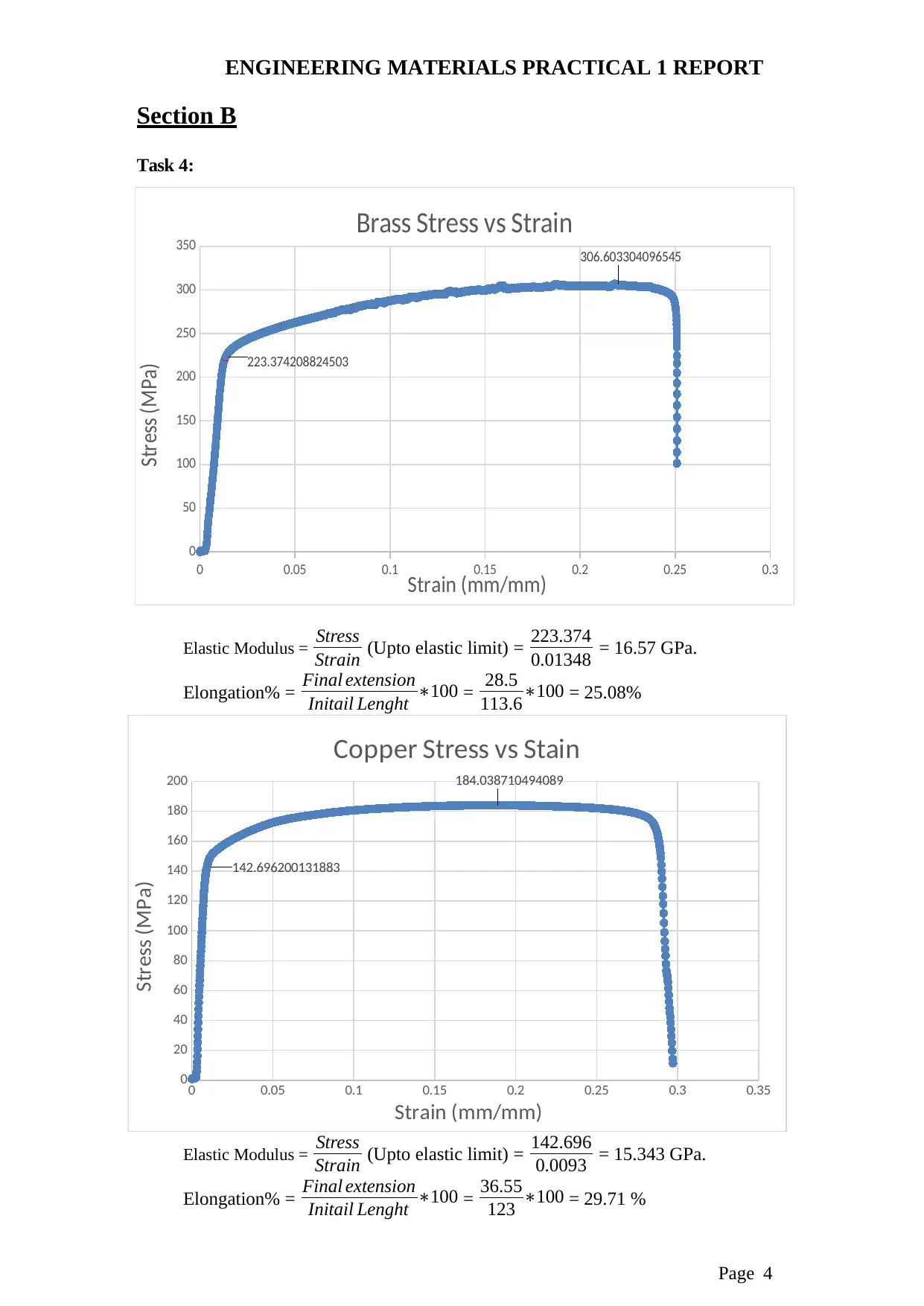
ENGINEERING MATERIALS PRACTICAL 1 REPORT
Page 4
Section B
Task 4:
Elastic Modulus = Stress
Strain (Upto elastic limit) = 223.374
0.01348 = 16.57 GPa.
Elongation% = Final extension
Initail Lenght ∗100 = 28.5
113.6∗100 = 25.08%
Elastic Modulus = Stress
Strain (Upto elastic limit) = 142.696
0.0093 = 15.343 GPa.
Elongation% = Final extension
Initail Lenght ∗100 = 36.55
123 ∗100 = 29.71 %
0 0.05 0.1 0.15 0.2 0.25 0.3 0.35
0
20
40
60
80
100
120
140
160
180
200
142.696200131883
184.038710494089
Copper Stress vs Stain
Strain (mm/mm)
Stress (MPa)
0 0.05 0.1 0.15 0.2 0.25 0.3
0
50
100
150
200
250
300
350
223.374208824503
306.603304096545
Brass Stress vs Strain
Strain (mm/mm)
Stress (MPa)
Page 4
Section B
Task 4:
Elastic Modulus = Stress
Strain (Upto elastic limit) = 223.374
0.01348 = 16.57 GPa.
Elongation% = Final extension
Initail Lenght ∗100 = 28.5
113.6∗100 = 25.08%
Elastic Modulus = Stress
Strain (Upto elastic limit) = 142.696
0.0093 = 15.343 GPa.
Elongation% = Final extension
Initail Lenght ∗100 = 36.55
123 ∗100 = 29.71 %
0 0.05 0.1 0.15 0.2 0.25 0.3 0.35
0
20
40
60
80
100
120
140
160
180
200
142.696200131883
184.038710494089
Copper Stress vs Stain
Strain (mm/mm)
Stress (MPa)
0 0.05 0.1 0.15 0.2 0.25 0.3
0
50
100
150
200
250
300
350
223.374208824503
306.603304096545
Brass Stress vs Strain
Strain (mm/mm)
Stress (MPa)
Paraphrase This Document
Need a fresh take? Get an instant paraphrase of this document with our AI Paraphraser
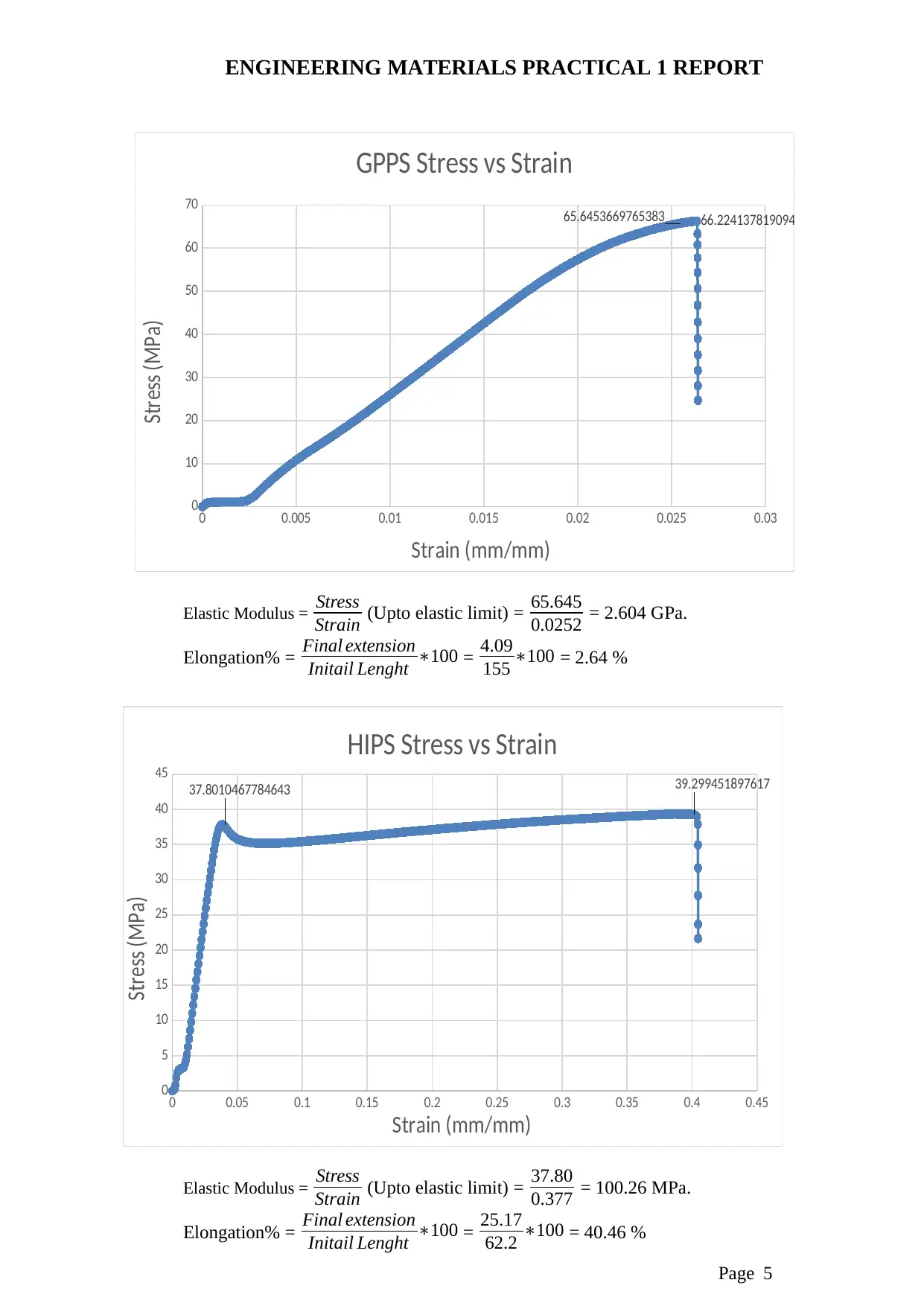
ENGINEERING MATERIALS PRACTICAL 1 REPORT
Page 5
Elastic Modulus = Stress
Strain (Upto elastic limit) = 65.645
0.0252 = 2.604 GPa.
Elongation% = Final extension
Initail Lenght ∗100 = 4.09
155 ∗100 = 2.64 %
Elastic Modulus = Stress
Strain (Upto elastic limit) = 37.80
0.377 = 100.26 MPa.
Elongation% = Final extension
Initail Lenght ∗100 = 25.17
62.2 ∗100 = 40.46 %
0 0.005 0.01 0.015 0.02 0.025 0.03
0
10
20
30
40
50
60
70 65.6453669765383 66.224137819094
GPPS Stress vs Strain
Strain (mm/mm)
Stress (MPa)
0 0.05 0.1 0.15 0.2 0.25 0.3 0.35 0.4 0.45
0
5
10
15
20
25
30
35
40
45
37.8010467784643 39.299451897617
HIPS Stress vs Strain
Strain (mm/mm)
Stress (MPa)
Page 5
Elastic Modulus = Stress
Strain (Upto elastic limit) = 65.645
0.0252 = 2.604 GPa.
Elongation% = Final extension
Initail Lenght ∗100 = 4.09
155 ∗100 = 2.64 %
Elastic Modulus = Stress
Strain (Upto elastic limit) = 37.80
0.377 = 100.26 MPa.
Elongation% = Final extension
Initail Lenght ∗100 = 25.17
62.2 ∗100 = 40.46 %
0 0.005 0.01 0.015 0.02 0.025 0.03
0
10
20
30
40
50
60
70 65.6453669765383 66.224137819094
GPPS Stress vs Strain
Strain (mm/mm)
Stress (MPa)
0 0.05 0.1 0.15 0.2 0.25 0.3 0.35 0.4 0.45
0
5
10
15
20
25
30
35
40
45
37.8010467784643 39.299451897617
HIPS Stress vs Strain
Strain (mm/mm)
Stress (MPa)
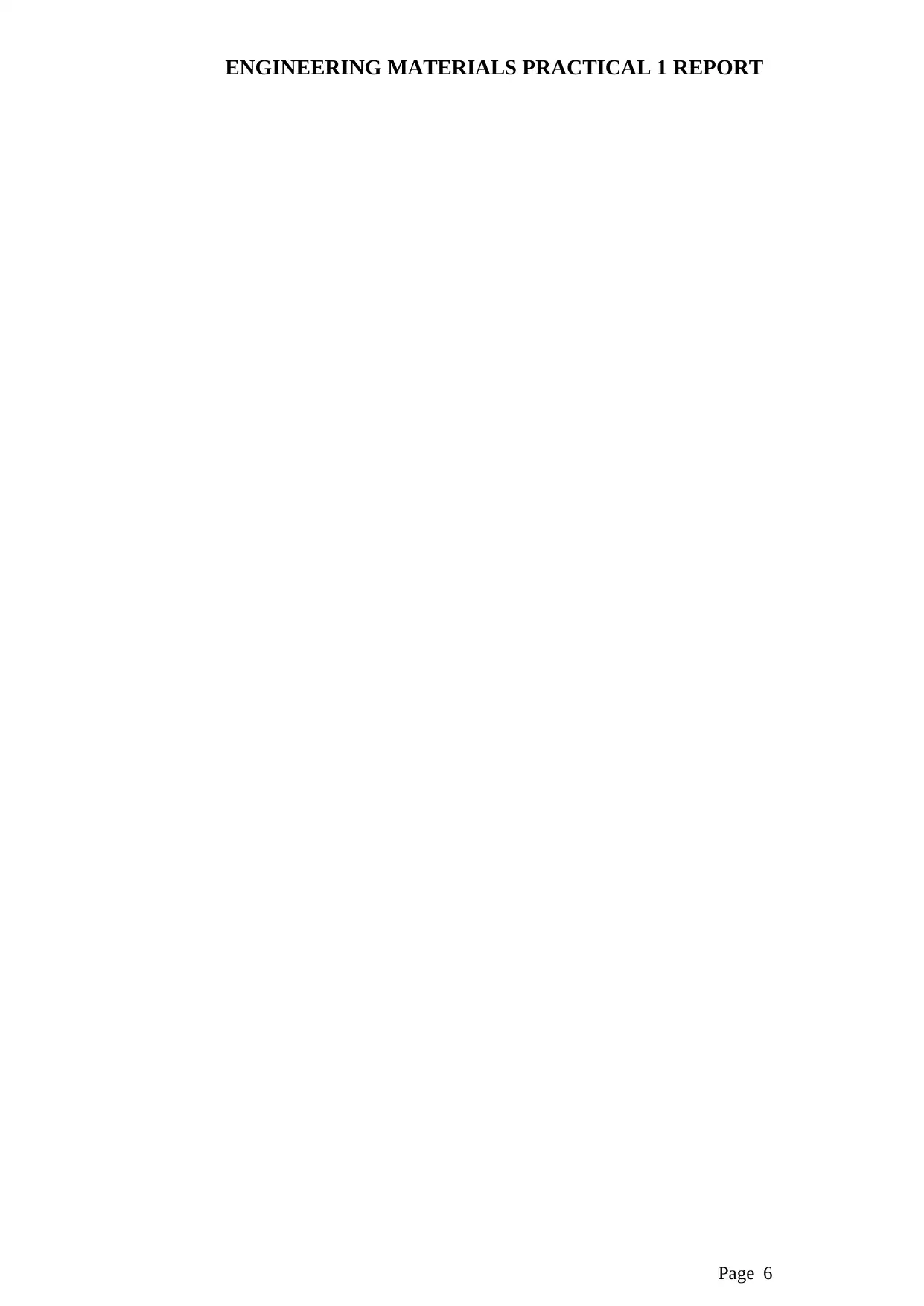
ENGINEERING MATERIALS PRACTICAL 1 REPORT
Page 6
Page 6
⊘ This is a preview!⊘
Do you want full access?
Subscribe today to unlock all pages.

Trusted by 1+ million students worldwide
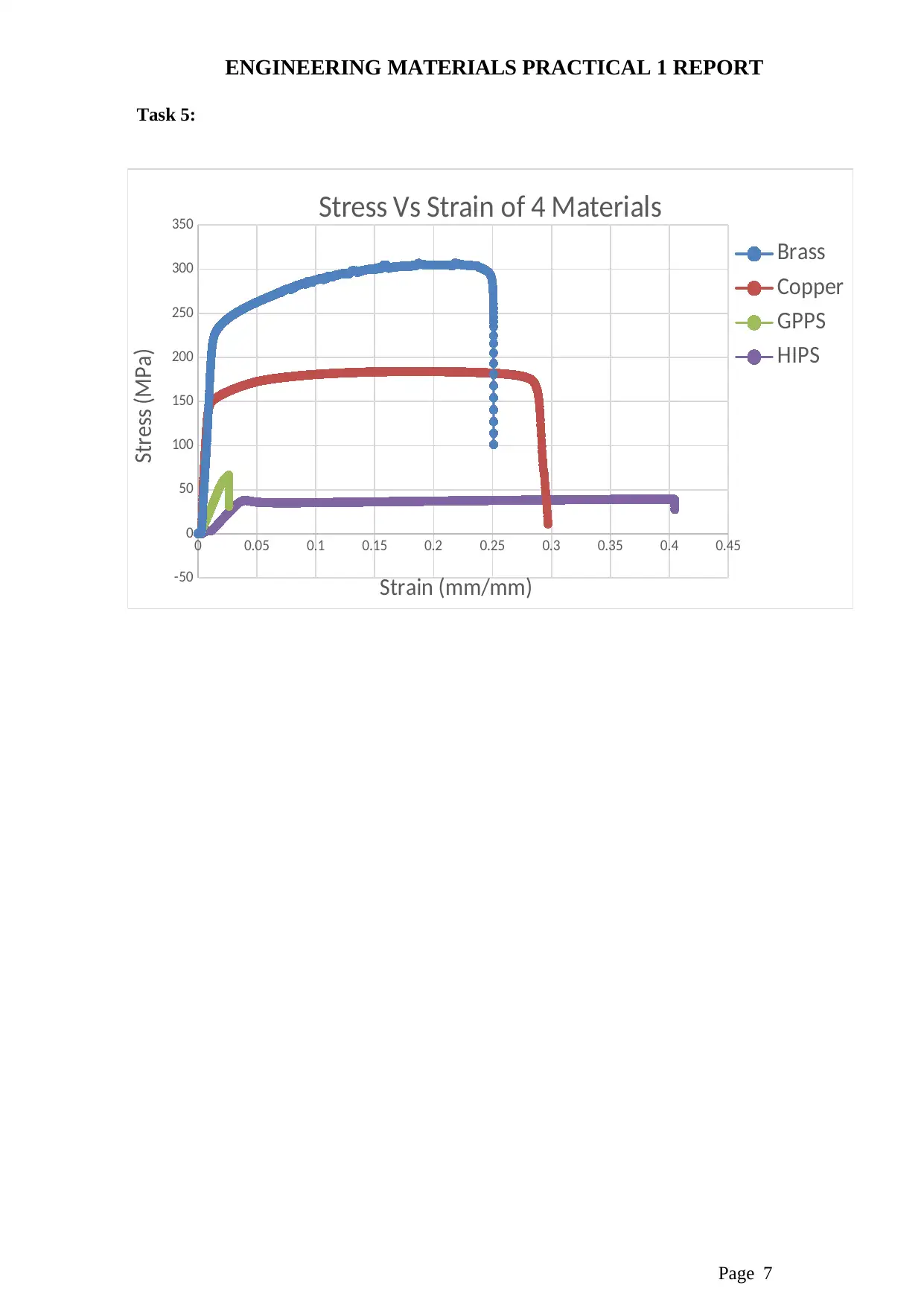
ENGINEERING MATERIALS PRACTICAL 1 REPORT
Page 7
Task 5:
0 0.05 0.1 0.15 0.2 0.25 0.3 0.35 0.4 0.45
-50
0
50
100
150
200
250
300
350 Stress Vs Strain of 4 Materials
Brass
Copper
GPPS
HIPS
Strain (mm/mm)
Stress (MPa)
Page 7
Task 5:
0 0.05 0.1 0.15 0.2 0.25 0.3 0.35 0.4 0.45
-50
0
50
100
150
200
250
300
350 Stress Vs Strain of 4 Materials
Brass
Copper
GPPS
HIPS
Strain (mm/mm)
Stress (MPa)
Paraphrase This Document
Need a fresh take? Get an instant paraphrase of this document with our AI Paraphraser
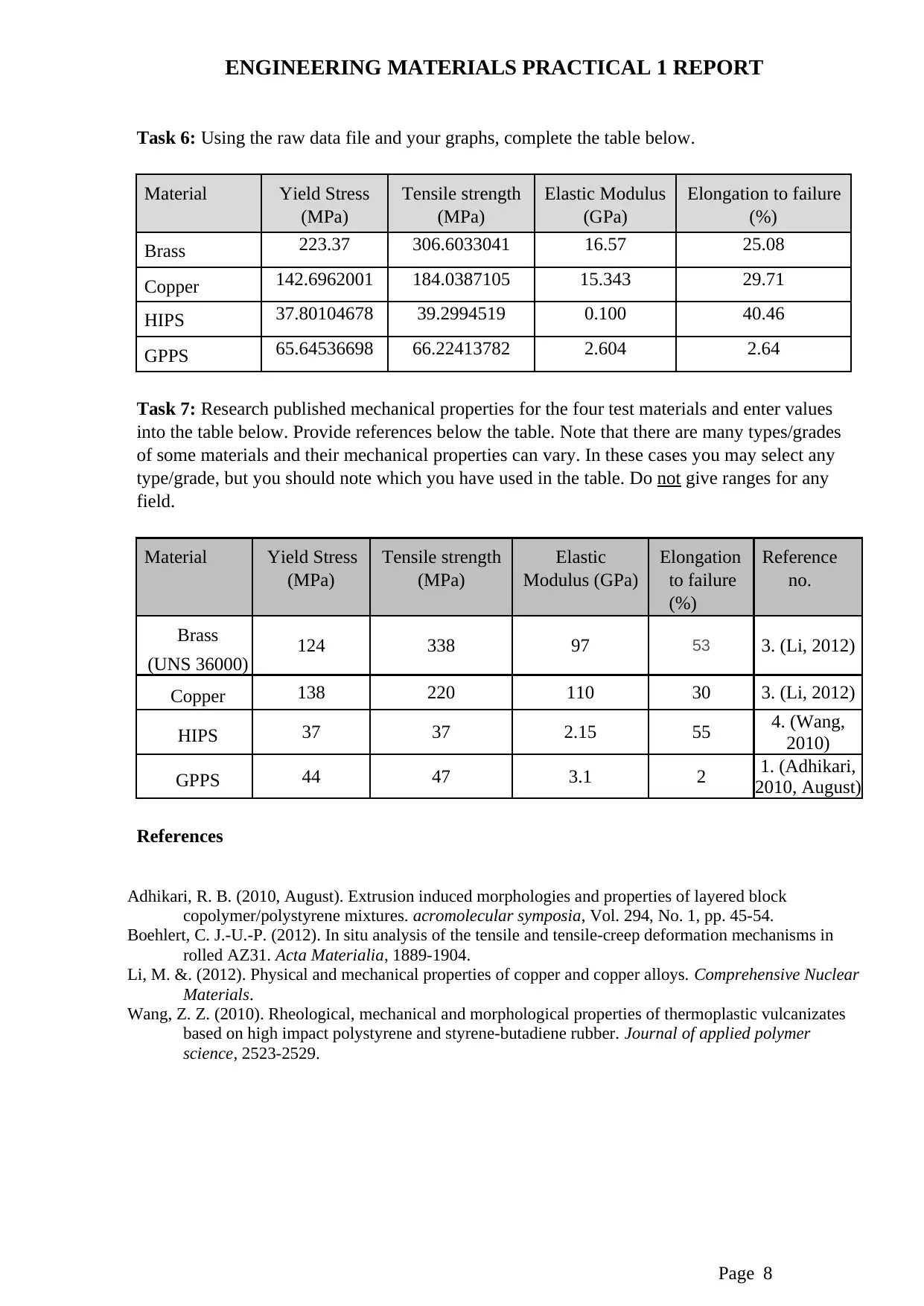
ENGINEERING MATERIALS PRACTICAL 1 REPORT
Page 8
Task 6: Using the raw data file and your graphs, complete the table below.
Material Yield Stress
(MPa)
Tensile strength
(MPa)
Elastic Modulus
(GPa)
Elongation to failure
(%)
Brass 223.37 306.6033041 16.57 25.08
Copper 142.6962001 184.0387105 15.343 29.71
HIPS 37.80104678 39.2994519 0.100 40.46
GPPS 65.64536698 66.22413782 2.604 2.64
Task 7: Research published mechanical properties for the four test materials and enter values
into the table below. Provide references below the table. Note that there are many types/grades
of some materials and their mechanical properties can vary. In these cases you may select any
type/grade, but you should note which you have used in the table. Do not give ranges for any
field.
Material Yield Stress
(MPa)
Tensile strength
(MPa)
Elastic
Modulus (GPa)
Elongation
to failure
(%)
Reference
no.
Brass
(UNS 36000) 124 338 97 53 3. (Li, 2012)
Copper 138 220 110 30 3. (Li, 2012)
HIPS 37 37 2.15 55 4. (Wang,
2010)
GPPS 44 47 3.1 2 1. (Adhikari,
2010, August)
References
Adhikari, R. B. (2010, August). Extrusion induced morphologies and properties of layered block
copolymer/polystyrene mixtures. acromolecular symposia, Vol. 294, No. 1, pp. 45-54.
Boehlert, C. J.-U.-P. (2012). In situ analysis of the tensile and tensile-creep deformation mechanisms in
rolled AZ31. Acta Materialia, 1889-1904.
Li, M. &. (2012). Physical and mechanical properties of copper and copper alloys. Comprehensive Nuclear
Materials.
Wang, Z. Z. (2010). Rheological, mechanical and morphological properties of thermoplastic vulcanizates
based on high impact polystyrene and styrene‐butadiene rubber. Journal of applied polymer
science, 2523-2529.
Page 8
Task 6: Using the raw data file and your graphs, complete the table below.
Material Yield Stress
(MPa)
Tensile strength
(MPa)
Elastic Modulus
(GPa)
Elongation to failure
(%)
Brass 223.37 306.6033041 16.57 25.08
Copper 142.6962001 184.0387105 15.343 29.71
HIPS 37.80104678 39.2994519 0.100 40.46
GPPS 65.64536698 66.22413782 2.604 2.64
Task 7: Research published mechanical properties for the four test materials and enter values
into the table below. Provide references below the table. Note that there are many types/grades
of some materials and their mechanical properties can vary. In these cases you may select any
type/grade, but you should note which you have used in the table. Do not give ranges for any
field.
Material Yield Stress
(MPa)
Tensile strength
(MPa)
Elastic
Modulus (GPa)
Elongation
to failure
(%)
Reference
no.
Brass
(UNS 36000) 124 338 97 53 3. (Li, 2012)
Copper 138 220 110 30 3. (Li, 2012)
HIPS 37 37 2.15 55 4. (Wang,
2010)
GPPS 44 47 3.1 2 1. (Adhikari,
2010, August)
References
Adhikari, R. B. (2010, August). Extrusion induced morphologies and properties of layered block
copolymer/polystyrene mixtures. acromolecular symposia, Vol. 294, No. 1, pp. 45-54.
Boehlert, C. J.-U.-P. (2012). In situ analysis of the tensile and tensile-creep deformation mechanisms in
rolled AZ31. Acta Materialia, 1889-1904.
Li, M. &. (2012). Physical and mechanical properties of copper and copper alloys. Comprehensive Nuclear
Materials.
Wang, Z. Z. (2010). Rheological, mechanical and morphological properties of thermoplastic vulcanizates
based on high impact polystyrene and styrene‐butadiene rubber. Journal of applied polymer
science, 2523-2529.
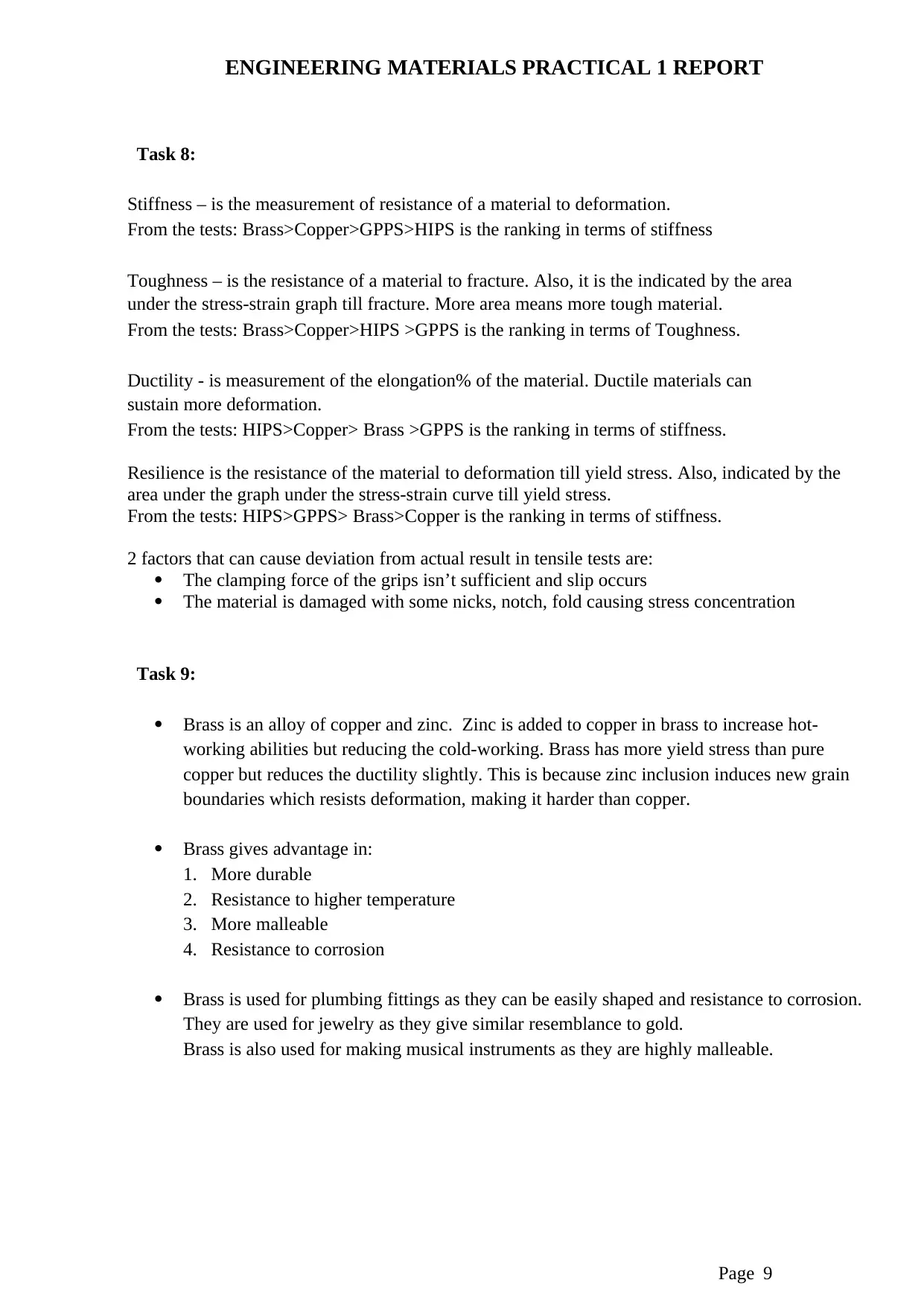
ENGINEERING MATERIALS PRACTICAL 1 REPORT
Page 9
Task 8:
Stiffness – is the measurement of resistance of a material to deformation.
From the tests: Brass>Copper>GPPS>HIPS is the ranking in terms of stiffness
Toughness – is the resistance of a material to fracture. Also, it is the indicated by the area
under the stress-strain graph till fracture. More area means more tough material.
From the tests: Brass>Copper>HIPS >GPPS is the ranking in terms of Toughness.
Ductility - is measurement of the elongation% of the material. Ductile materials can
sustain more deformation.
From the tests: HIPS>Copper> Brass >GPPS is the ranking in terms of stiffness.
Resilience is the resistance of the material to deformation till yield stress. Also, indicated by the
area under the graph under the stress-strain curve till yield stress.
From the tests: HIPS>GPPS> Brass>Copper is the ranking in terms of stiffness.
2 factors that can cause deviation from actual result in tensile tests are:
The clamping force of the grips isn’t sufficient and slip occurs
The material is damaged with some nicks, notch, fold causing stress concentration
Task 9:
Brass is an alloy of copper and zinc. Zinc is added to copper in brass to increase hot-
working abilities but reducing the cold-working. Brass has more yield stress than pure
copper but reduces the ductility slightly. This is because zinc inclusion induces new grain
boundaries which resists deformation, making it harder than copper.
Brass gives advantage in:
1. More durable
2. Resistance to higher temperature
3. More malleable
4. Resistance to corrosion
Brass is used for plumbing fittings as they can be easily shaped and resistance to corrosion.
They are used for jewelry as they give similar resemblance to gold.
Brass is also used for making musical instruments as they are highly malleable.
Page 9
Task 8:
Stiffness – is the measurement of resistance of a material to deformation.
From the tests: Brass>Copper>GPPS>HIPS is the ranking in terms of stiffness
Toughness – is the resistance of a material to fracture. Also, it is the indicated by the area
under the stress-strain graph till fracture. More area means more tough material.
From the tests: Brass>Copper>HIPS >GPPS is the ranking in terms of Toughness.
Ductility - is measurement of the elongation% of the material. Ductile materials can
sustain more deformation.
From the tests: HIPS>Copper> Brass >GPPS is the ranking in terms of stiffness.
Resilience is the resistance of the material to deformation till yield stress. Also, indicated by the
area under the graph under the stress-strain curve till yield stress.
From the tests: HIPS>GPPS> Brass>Copper is the ranking in terms of stiffness.
2 factors that can cause deviation from actual result in tensile tests are:
The clamping force of the grips isn’t sufficient and slip occurs
The material is damaged with some nicks, notch, fold causing stress concentration
Task 9:
Brass is an alloy of copper and zinc. Zinc is added to copper in brass to increase hot-
working abilities but reducing the cold-working. Brass has more yield stress than pure
copper but reduces the ductility slightly. This is because zinc inclusion induces new grain
boundaries which resists deformation, making it harder than copper.
Brass gives advantage in:
1. More durable
2. Resistance to higher temperature
3. More malleable
4. Resistance to corrosion
Brass is used for plumbing fittings as they can be easily shaped and resistance to corrosion.
They are used for jewelry as they give similar resemblance to gold.
Brass is also used for making musical instruments as they are highly malleable.
⊘ This is a preview!⊘
Do you want full access?
Subscribe today to unlock all pages.

Trusted by 1+ million students worldwide
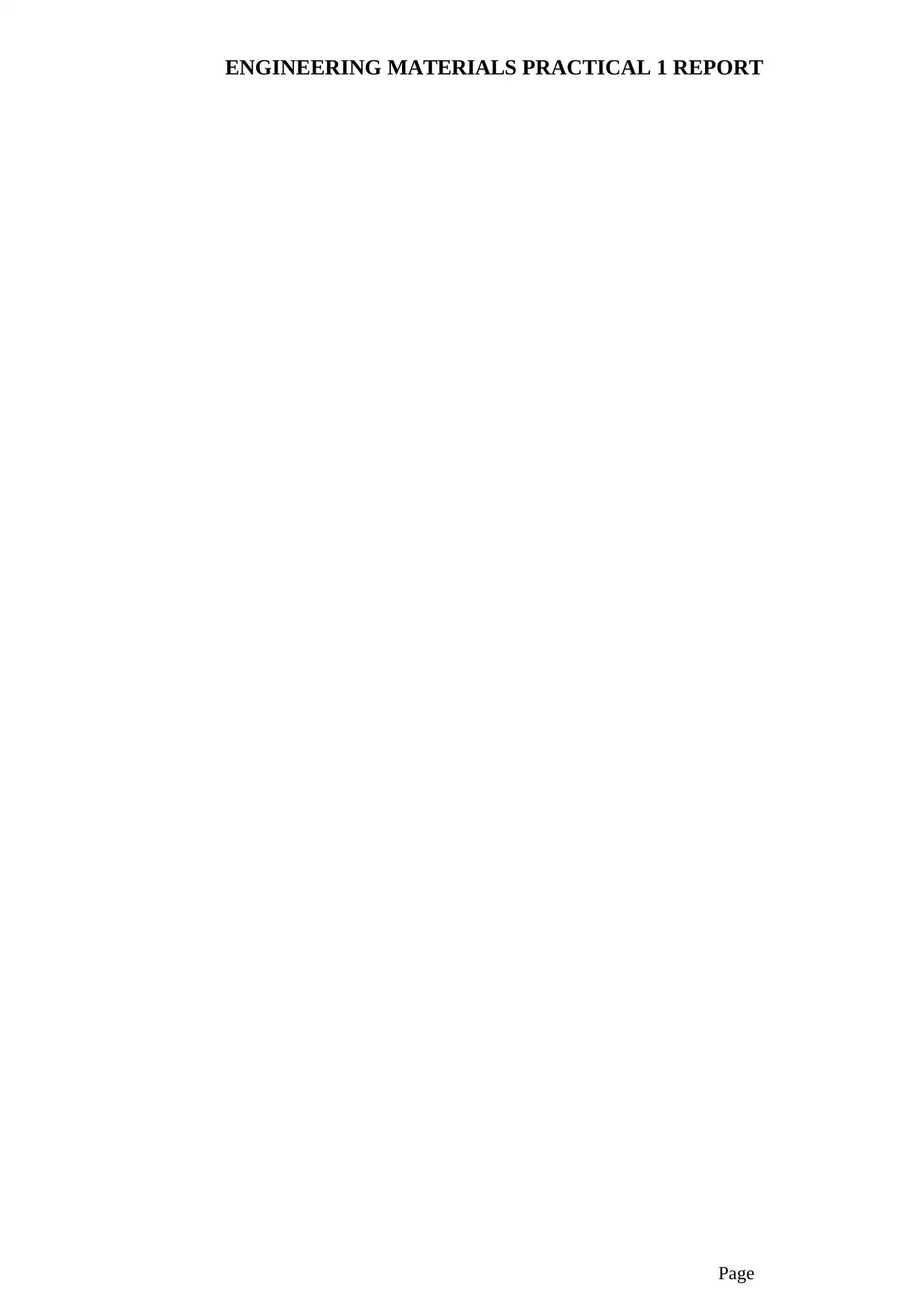
ENGINEERING MATERIALS PRACTICAL 1 REPORT
Page
10
Page
10
Paraphrase This Document
Need a fresh take? Get an instant paraphrase of this document with our AI Paraphraser

ENGINEERING MATERIALS PRACTICAL 1 REPORT
Page
11
Assessment feedback
Engineering Materials RENG1005 Practical 1 Report
Key components of this assignment Comment by marker
Understanding of question and task topics:
Clarity of answers, and relevance to the question/
task
Use of graphs, illustrations and data from
appropriate resources
Use of references
Summary comment
The Graduate qualities being assessed by this assignment are indicated by an X:
X GQ1: operate effectively with
and upon a body of knowledge
GQ5: are committed to ethical
action and social
responsibility
X GQ2: are prepared for lifelong learning X GQ6: communicate effectively
X GQ3: are effective problem solvers GQ7: demonstrate an
international perspective
GQ4:can work both autonomously and
collaboratively
Assignment grade/mark
Page
11
Assessment feedback
Engineering Materials RENG1005 Practical 1 Report
Key components of this assignment Comment by marker
Understanding of question and task topics:
Clarity of answers, and relevance to the question/
task
Use of graphs, illustrations and data from
appropriate resources
Use of references
Summary comment
The Graduate qualities being assessed by this assignment are indicated by an X:
X GQ1: operate effectively with
and upon a body of knowledge
GQ5: are committed to ethical
action and social
responsibility
X GQ2: are prepared for lifelong learning X GQ6: communicate effectively
X GQ3: are effective problem solvers GQ7: demonstrate an
international perspective
GQ4:can work both autonomously and
collaboratively
Assignment grade/mark
1 out of 11
Related Documents
Your All-in-One AI-Powered Toolkit for Academic Success.
+13062052269
info@desklib.com
Available 24*7 on WhatsApp / Email
![[object Object]](/_next/static/media/star-bottom.7253800d.svg)
Unlock your academic potential
Copyright © 2020–2025 A2Z Services. All Rights Reserved. Developed and managed by ZUCOL.





